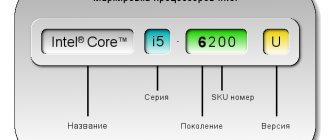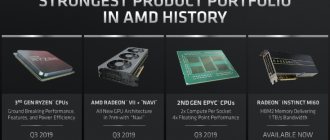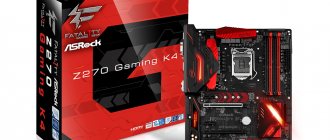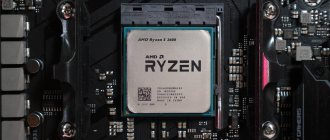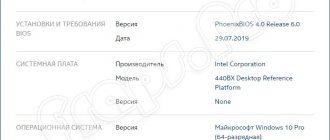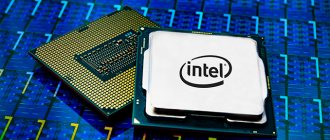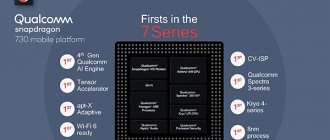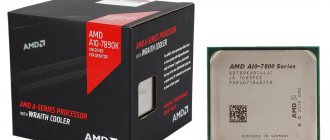Article content
Intel announced the release of new Comet Lake family of chips to replace the eighth generation of Coffee Lake and Whiskey Lake systems. The problem arises when we realize that there is another family of systems on the market that belong to 10 generations of Intel Core processors. I'm talking about Ice Lake of course.
We have processor choices, manufacturing process differences, graphics performance, core counts, and power consumption. This is enough for an ordinary user who is not interested in technology to get lost every day. Of course, even many more advanced Internet users who keep up with technological innovation will have trouble identifying and distinguishing between processors. Even Intel itself admits that there may be some confusion on the market due to the premiere of 10th generation systems. In our opinion, laptop buyers will soon have a tough nut to crack.
The 8th-gen design will remain on the market, with new 10th-gen Ice Lake systems manufactured at 10nm and Comet Lake manufactured at 14nm. Let it not be so simple, we are talking only about ultra-mobile designs. Gaming laptops are equipped with other systems belonging to the ninth generation. Ninth-generation Intel Core chips are not available for ultramobile computers.
We review all 19 of Intel's new 10th Gen processors. And we will try to find the strengths and weaknesses of processors. We have already completed the first tests of Ice Lake chips and know that the new Comet Lake chips have much in common with the popular Whiskey Lake processors.
In the introduction, we present the entire line of 10th generation Intel Core processors:
Laptops with 19 new 10th-gen chips will soon be available in stores, and it's possible that Intel will introduce more processors in the future.
There are already many computers on the market equipped with different chips, and soon the situation will become even more complicated. In this case, buyers may have big problems choosing the right mobile processor for them.
If the buyer is a typical consumer who does not care about code names, manufacturing process, clock speed, number of cores, GPU execution units, but at the same time does not want to buy a computer that will be too inefficient for us, we have created special sections in which We tell you which layouts are suitable for the most popular tasks such as gaming, office work, rendering, etc.
Which 10th generation processor is best for me?
Each user has different needs. Some people demand the best possible performance from their computer, but in reality this is very little. The vast majority of buyers want to buy a computer that will only be able to run games and solve their problems without problems for many years. Battery life and graphics performance are also important.
We have prepared six popular aspects that buyers pay attention to, and based on which we advise which processor is the best in this category.
Here are all the features:
- Durability and support for new instructions
- Video encoding performance (Intel Quick Sync)
- Multi-threaded performance (for example, video editing)
- Single-threaded performance (office work)
- Gaming and graphics performance
- Battery life
A lot of heat
It's good that Intel has made every effort to improve thermal efficiency, because some of these processors can get very hot. The top-tier Comet Lake processors—Core i9-10900K, Core i7-10700K, and Core i5-10600K—can generate up to 125W of heat under intense workloads. Its measurement is called thermal design power, or TDP.
All this means is that the PC needs a powerful cooler to keep the top-tier Comet Lake monsters from getting too hot.
Related article: What is TDP for CPUs and GPUs?
Durability and support for new instructions
Most users replace their computer more than once every few years. Some of them only do this when the old computer breaks down completely or is so slow that it cannot be used comfortably. It is for this reason that customers often look for proven equipment that will last for many years.
In 10 nm Ice Lake systems, Intel added support for AVX512 instructions, which can speed up AI calculations. The result could be performance improvements in the future, such as graphics applications that will be able to recognize faces faster and with greater accuracy than before. Features like AVX512 are now called future-proof because the truth is that at the moment, and also in the next few months, you will not be able to use the new instructions in popular applications. Developers need time to implement them in their programs.
Is it worth buying for the future? A flagship example is Intel Pentium III processors with SSE support. SSE instructions were no longer used after sales began in 1999, but they became very useful a few years later when MP3 files became popular.
For Intel Core 10 generation processors, only Ice Lake chips allow the use of AVX 512.
Here are the best processors in this category: Core i7-1068G7, Core i7-1065G7, Core i5-1035G7, Core i5-1035G4, Core i5-1035G1, Core i3-1005G1, Core i7-1060G7, Core i5-1030G7, Core i5- 1030G4, Core i3-1000G4 and Core i3-1000G1
Processors that will stand the test of time and do not have AVX512 support are Core i7-10710U, Core i7-10510U, Core i5-10210U, Core i3-10110U, Core i7-10510Y, Core i5-10310Y, Core i5-10210Y, Core i3- 10110Y
Many cores
Comet Lake processors have many cores. The Core i9-10900K is a top-end chip with 10 cores and 20 threads. CPU cores process system instructions and make your computer work its magic. The more cores, the more instructions the system can process simultaneously. The system will also work better.
The only catch is that software developers have to use all these wonderful kernels. Many don't, either because they don't need as much power or their software isn't optimized for multi-core machines.
However, if your workload involves heavy applications such as photo or video editing, or gaming, then all of these cores can help.
Related Article: CPU Basics: Multiple Processors, Cores, and Hyper-Threading
Video encoding performance
Fast Sync is a specialized video encoding feature available on graphics integrated with 10th Gen Intel processors. Ice Lake processors used the latest encoding engine, which can be much faster. The difference will be especially noticeable when using the new HEVC/H.265 codecs. Applications will need to update similarly to the AVX512, but when they do, there will be a noticeable performance boost.
For all users who plan to convert videos, we recommend layouts from the Ice Lake family.
Here are the best processors in this category: Intel Core i7-1068G7, Core i7-1065G7, Core i5-1035G7, Core i5-1035G4, Core i5-1035G1, Core i3-1005G1, Core i7-1060G7, Core i5-1030G7, Core i5 -1030G4, Core i3-1000G4 and Core i3-1000G1
Comet Lake family processors – Intel Core i7-10710U, Core i7-10510U, Core i5-10210U, Core i3-10110U, Core i7-10510Y, Core i5-10310Y, Core i5-10210Y, Core i3-10110Y will have similar performance, Lake whiskey systems are currently in their eighth generation.
Comparison table of the best Intel processors
| Name | Main characteristics | Price |
| Core i5-8400 | Eighth generation i5, 8th generation 6-core processor with a core frequency of 2.8GHz, can be boosted up to 4GHz. | ₽ 14 990 |
| Core i7 Devil's Canyon | 4 cores, each frequency is 4 GHz, there is an integrated graphics core. | ₽ 27 160 |
| Xeon E5-2697V3 | It has 14 cores with a frequency of 2.6 GHz, and the volume of its L3 cache is 40 MB, the heat dissipation is low for such a multi-core processor - 145 W. | ₽ 82 758 |
| Intel Xeon X5550 Gainestown | 4 cores and 2.67 GHz, low heat dissipation (95 W) and power consumption (60 W). | ₽ 11 197 |
| Core i5-6600 | 4 cores, frequency 3.3 GHz, and with TurboBoost it increases to 3.9 GHz, cache size - 6144 KB, heat dissipation - 65 W. | ₽ 18 670 |
| Celeron Conroe-L | A single-core processor without any special technical frills, with a small cache - most often 512 KB. | ₽ 19 100 |
| Intel Core i5-6500 | 4 cores, 3.2 GHz (overclocked with one button to 3.6 GHz), cache size is 6,144 KB, integrated graphics – HD Graphics 530. | ₽ 17 170 |
| Core i3 8100 | The processor has 4 cores with a frequency of 3.6 GHz, heat dissipation is only 65 W. | ₽ 7 597 |
| Core i7-7700T | It has 4 cores, a frequency of 2.9 GHz (overclocked to 3.8 GHz), powerful integrated graphics, 8192 KB L3 cache, very low heat dissipation - 35 W. | ₽ 25 000 |
| Intel Xeon X3210 | Powered by Kentsfield quad-core 2.13 GHz. | ₽ 15 194 |
Multi-threaded performance
For multi-threaded performance, the more cores and threads the better. They are especially useful when creating advanced high-definition video content and performing complex tasks such as 3D modeling or advanced photo processing.
Multi-core performance is also important when running multiple applications simultaneously. A processor with more cores will perform better even at lower clock speeds. For this reason, Comet Lake wins in this category.
The best chip will be the six-core Intel Core i7-10710U processor.
Intel Core i7-1068G7, Core i7-1065G7, Core i5-1035G7, Core i5-1035G4, Core i5-1035G1, Core i7-10510U and Core i5-10210U processors will perform very well.
The systems work well Intel Core i7-10510Y, Core and Core, i5-10310Y i5-10210Y.
The worst, but still satisfactory in this category are the following chips: Core i3-1005G1, Core i7-1060G7, Core i5-1030G7, Core i5-1030G4, Core i3-1000G4 and Core i3-1000G1, Core i3-10110U and Core i3 -10110Y.
Top 10 Intel Processors
To make it easier for you to navigate, we have selected the best from dozens of presented models, dividing them into categories. Let's look at the best gaming, premium, inexpensive and flagship processors, a model for simple tasks, as well as Intel processors in the Core i3, i5, i7 and Xeon lines.
Best Intel Gaming Processors
Core i5-8400
The model from the eighth generation i5 line is notable for the fact that its power, coupled with a good video card, will be just enough to not experience any inconvenience when running any modern game. You don't have to compromise and reduce the quality of graphics, or play at low frame rates - and at the same time, the model does not over-power and is available at a reasonable price of 14,000 - 17,000 rubles.
For this amount you will get an 8th generation 6-core processor with a core frequency of 2.8 GHz. It can be increased to 4 GHz, but in this case you need to take care of good cooling. The possibility of such strong overclocking will allow the processor to remain relevant for quite a long time. Overall, this is one of the best gaming processors available at a reasonable price.
Price: RUB 14,990
Core i7 Devil's Canyon
A more powerful processor than the previous one reviewed, it will allow even the most demanding users to enjoy perfect pictures and high frame rates. However, it has only 4 cores, each with a frequency of 4 GHz. The overclocking potential is lower than that of the same i5-8400 - the model gets seriously hot even without overclocking. However, with powerful cooling it can achieve a frequency of 4.9 GHz.
There is an integrated graphics core. In general, this processor was one of the most powerful in 2014-2015, but has now lost ground, but even now its power is enough for games. The cost is from 26,000 to 30,000 rubles, which can still be considered a rather high price, considering that the peak of possibilities has already been passed.
Price: RUB 27,160
The best Intel processors in the premium segment
Xeon E5-2697V3
A representative of the most powerful line from Intel, it was created for those who do not consider spending money to get the best equipment, and its performance is amazing even despite its advanced age (released 5 years ago). It has 14 cores with a frequency of 2.6 GHz, and its L3 cache is 40 MB. The heat dissipation is low for such a multi-core processor - 145 W.
Even as a server processor, it is compatible with many gaming motherboards, so you can equip your home computer with it if you wish. But it will not be cheap: this model costs approximately 83,000 rubles. Small disadvantages include weak overclocking - only up to 3 GHz, and the lack of integrated graphics - however, owners of such processors usually do not need it.
Price: RUB 82,758
Best inexpensive Intel processor
Intel Xeon X5550 Gainestown
Another representative of the Xeon line, but much cheaper than the previous one - it is available for 11,000 - 13,000 rubles (and can be found significantly cheaper). Of course, it is also much inferior in power to the previous model: 4 cores and 2.67 GHz. The Gainestown core is already considered obsolete, but nevertheless, even now the processor produces a very decent level of performance, because it was once one of the leading models.
Low heat generation (95 W) and power consumption (60 W) are the advantages of this model. But there is also a minus - difficulties in finding a modern motherboard for it. In general, this model is a good option for a powerful computer at a reasonable price.
Price: RUB 11,197
Best Intel Flagship Processor
Core i5-6600
It costs 15,000 - 19,000 and gives good performance. 4 cores, frequency 3.3 GHz, and with TurboBoost it increases to 3.9 GHz. Cache volume – 6144 KB, heat dissipation – 65 W. These characteristics are enough to ensure that in most modern games, having a powerful video card in addition to the processor, you will not feel any inconvenience. The most demanding ones may still force you to lower the settings a little.
And here we come to the problem of this processor - yet it is inferior to the most modern solutions in the mid-price segment in terms of performance, and at the same time it is not always cheaper. Thus, it is significantly inferior to the previously reviewed i5-8400 - and it can be purchased cheaper. This takes it out of the list of leaders - priority should still be given to other models from Intel.
Price: RUB 18,670
The best Intel processor for light tasks
Celeron Conroe-L
If there is no particular load on the processor, and a computer based on it will be used for simple tasks: surfing the Internet, watching videos, and the like, you can save on the processor by purchasing a model from the Celeron Conroe-L line. Such processors can cost very little: the cheapest ones even cost less than 19,000 rubles, although they can rarely be found in stores and are often bought secondhand.
These are single-core processors without any special technical frills and with a small cache - most often 512 KB. But they also have low heat dissipation, which makes them optimal for a system from which not much is required.
Price: ₽ 19,100
The best Intel processor in the Core i5 line
Intel Core i5-6500
This is a junior model in relation to the one discussed earlier, it is noticeably cheaper - about 15,000 rubles, and at the same time it is not much inferior. 4 cores, 3.2 GHz (overclocked with one button to 3.6 GHz), cache size is 6,144 KB.
Integrated graphics – HD Graphics 530, provides pretty good performance. Of course, the video card will not fully replace it, but in not the newest games, such a graphics chip will be enough. The processor features moderate heat generation and high reliability. Now, when several generations have passed since its release, the cost has dropped significantly, but it is still not bad.
Price: RUB 17,170
The best Intel processor in the Core i3 line
Core i3-8100
It can give a head start to representatives of the older lines of previous generations. So, its performance is higher than that of the i5-7600. At the same time, the cost is very low - approximately from 8,000 to 9,500 rubles. this makes the processor an excellent choice for budget-conscious buyers. still wanting to take a productive solution.
The processor has 4 cores with a frequency of 3.6 GHz, heat dissipation is only 65 W. These parameters make the model the best choice if you need to spend less than 10,000. Its parameters are higher than all analogues in price.
Price: RUB 7,597
The best Intel processor in the Core i7 line
Core i7-7700T
The latest i7s are expensive, which makes recommending them very cautious. But representatives of the generation before last have seriously lost in price: for example, the 7700T costs about 25,000 rubles. The processor has 4 cores, a frequency of 2.9 GHz (overclocked to 3.8 GHz), powerful integrated graphics, 8192 KB L3 cache. The heat dissipation is very low - 35 W.
Of course, this model will not be able to compete with the company’s newest flagships, but nevertheless its performance is quite enough for the latest games or 3D modeling. Considering the moderate cost - a good choice, although there are solutions of similar power and at a lower price - first of all you should pay attention to the most modern i3 and i5.
Price: ₽ 25,000
Best Xeon processor
Intel Xeon X3210
The most powerful of the Xeon line cost hundreds of thousands, or even millions, but we will look at a much less ambitious model - its price is only 15,000 rubles. For this amount you will get a Kentsfield-based device with four 2.13 GHz cores.
The X3210 is a solution with high overclocking potential at a low price, although it is somewhat outdated: it affects that the processor has been on the market for a long time. However, like all representatives of the Xeon line, it is a real long-liver, because in the first years after its release it was too powerful for ordinary home computers. But still, new solutions from Intel are superior in many ways.
Price: RUB 15,194
Single thread performance
Multi-threaded performance is required, which is why manufacturers are looking to continually increase the number of cores, but you can't do it with impunity because most applications, even new ones, don't typically use multiple cores. The trick is to create a processor with a significant number of cores that also has satisfactory single-threaded performance.
Applications often put a lot of stress on one or two cores that run at high frequencies. In this case, time is important. In this category, systems with high synchronization and the ability to maintain it while operating under full load win. In this case, Comet Lake processors with clock speeds up to 4.9 GHz can outperform 10nm Ice Lake systems.
However, it is also important to remember that time must be used wisely, and in this case, Ice Lake processors perform better.
The Intel Core i7-10710U and Core i7-10510U win in this category.
Intel Core i7-1068G7, i7-1065G7 Key, Core i5-1035G7, i5-1035G4 Key, Core i5-1035G1 processors fall very well
Intel Core i5-10210U, Core i3-1005G1 and Core i3-10110U chips will perform well.
The worst, but still satisfactory in this category, can handle: Intel Core i7-10510Y, Core i5-10310Y Core i5-10210Y, Core i3-10110Y, Core i7-1060G7, Core i5-1030G7, Core i5-1030G4, Core i3 -1000G4, Core i3-1000G1
10th generation Intel Core processors debuted for the LGA1200 platform
Today, Intel officially announced its 10th generation Core processors, also known as Comet Lake-S, along with the mainstream LGA1200 platform. The socket of the same name has replaced LGA1151-v2 and will be found in motherboards based on 400 series chipsets. New CPUs and motherboards for them will go on sale in the second half of May.
In total, Intel will bring to market over three dozen Comet Lake-S processors. They are produced using an improved 14nm process technology, and from a microarchitecture point of view they differ little from Skylake-S, released back in 2020. The UHD Graphics 630 graphics unit was completely “migrated” from the Coffee Lake-S chips without any changes.
The main features of the 10th generation Core CPU include an increased number of x86 cores, support for Hyper-Threading by all Core solutions, and improved dynamic overclocking algorithms. In particular, the new Intel Core i9 supports Thermal Velocity Boost technology, which was previously tested in laptops. If the cooling system allows, then during dynamic overclocking their frequencies will be raised above the standard Turbo Boost 2.0 limits.
To keep the operating temperatures of the 10th generation Core CPU at an acceptable level, Intel not only used solder, but also made the CPU die thinner and increased the thickness of the heat distribution cover.
In the press release, Intel also notes the ability to disable Hyper-Threading for individual cores and PEG/DMI overclocking, improved control over the frequency/voltage curve, support for the 2.5-gigabit Intel I225 Foxville network controller (already the latest revision), the Thunderbolt 3 interface and Wi-Fi 6 wireless module AX201.
The new line is headed by the “fastest gaming processor” Core i9-10900K. It has ten physical cores, 20 MB of L3 cache, a dual-channel DDR4-2933 controller, an unlocked multiplier and is characterized by a 125-watt thermal package.
| CPU | Cores/threads | Rated frequency, GHz | Turbo Boost 2.0 (single / all cores), GHz | Turbo Boost Max 3.0, GHz | Thermal Velocity Boost (single/all cores), GHz | TDP, W | Price |
| Core i9-10900K | 10 / 20 | 3,7 | 5,1 / 4,8 | 5,2 | 5,3 / 4,9 | 125 | $488 |
| Core i9-10900KF | 10 / 20 | 3,7 | 5,1 / 4,8 | 5,2 | 5,3 / 4,9 | 125 | $472 |
| Core i9-10900 | 10 / 20 | 2,8 | 5,0 / 4,5 | 5,1 | 5,2 / 4,6 | 65 | $439 |
| Core i9-10900F | 10 / 20 | 2,8 | 5,0 / 4,5 | 5,1 | 5,2 / 4,6 | 65 | $422 |
| Core i7-10700K | 8 / 16 | 3,8 | 5,0 / 4,7 | 5,1 | 125 | $374 | |
| Core i7-10700KF | 8 / 16 | 3,8 | 5,0 / 4,7 | 5,1 | 125 | $349 | |
| Core i7-10700 | 8 / 16 | 2,9 | 4,7 / 4,6 | 4,8 | 65 | $323 | |
| Core i7-10700F | 8 / 16 | 2,9 | 4,7 / 4,6 | 4,8 | 65 | $298 | |
| Core i5-10600K | 6 / 12 | 4,1 | 4,8 / 4,5 | 125 | $262 | ||
| Core i5-10600KF | 6 / 12 | 4,1 | 4,8 / 4,5 | 125 | $237 | ||
| Core i5-10600 | 6 / 12 | 3,3 | 4,8 / 4,4 | 65 | $213 | ||
| Core i5-10500 | 6 / 12 | 3,1 | 4,5 / 4,2 | 65 | $192 | ||
| Core i5-10400 | 6 / 12 | 2,9 | 4,3 / 4,0 | 65 | $182 | ||
| Core i5-10400F | 6 / 12 | 2,9 | 4,3 / 4,0 | 65 | $157 | ||
| Core i3-10320 | 4 / 8 | 3,8 | 4,6 / 4,4 | 65 | $154 | ||
| Core i3-10300 | 4 / 8 | 3,7 | 4,4 / 4,2 | 65 | $143 | ||
| Core i3-10100 | 4 / 8 | 3,6 | 4,3 / 4,1 | 65 | $122 | ||
| Pentium Gold G6600 | 2 / 4 | 4,2 | 58 | $86 | |||
| Pentium Gold G6500 | 2 / 4 | 4,1 | 58 | $75 | |||
| Pentium Gold G6400 | 2 / 4 | 4,0 | 58 | $64 | |||
| Celeron G5920 | 2 / 2 | 3,5 | 58 | $52 | |||
| Celeron G5900 | 2 / 2 | 3,4 | 58 | $42 |
Together with regular Comet Lake-S CPUs, the chipmaker presented energy-efficient T-series solutions with a 35-watt TDP.
| CPU | Cores/threads | Rated frequency, GHz | Turbo Boost 2.0 (single / all cores), GHz | Turbo Boost Max 3.0, GHz | TDP, W | Price |
| Core i9-10900T | 10 / 20 | 1,9 | 4,5 / 3,7 | 4,6 | 35 | $439 |
| Core i7-10700T | 8 / 16 | 2,0 | 4,4 / 3,7 | 4,5 | 35 | $325 |
| Core i5-10600T | 6 / 12 | 2,4 | 4,0 / 3,7 | 35 | $213 | |
| Core i5-10500T | 6 / 12 | 2,3 | 3,8 / 3,5 | 35 | $192 | |
| Core i5-10400T | 6 / 12 | 2,0 | 3,6 / 3,2 | 35 | $182 | |
| Core i3-10300T | 4 / 8 | 3,0 | 3,9 / 3,7 | 35 | $143 | |
| Core i3-10100T | 4 / 8 | 3,0 | 3,8 / 3,5 | 35 | $122 | |
| Pentium Gold G6500T | 2 / 4 | 3,5 | 35 | $75 | ||
| Pentium Gold G6400T | 2 / 4 | 3,4 | 35 | $64 | ||
| Celeron G5900T | 2 / 2 | 3,2 | 35 | $42 |
Motherboards with LGA1200 processor socket will be announced soon. We have already talked about some products based on the Intel Z490 chipset in separate materials: ASRock, Gigabyte and MSI.
Gaming and graphics performance
For gaming and when graphics performance is important, the Ice Lake family is the best choice. With this generation, Intel processors have significantly improved integrated graphics performance.
Comet Lake systems continue to feature Intel UHD Graphics 620 graphics cards, already well known from seventh and eighth generation processors.
Intel Core i7-1068G7, Core i7-1065G7, Core i5-1035G7 processors win in this category.
The Intel Core i7-1060G7 and Core i5-1030G7 chips perform very well.
Intel Core i5-1035G4, Core and i5-1030G4 i3-1000G4 chips perform well
On average, Intel Core i5-1035G1, Core i3-1005G1 and Core i3-1000G1 processors fall out
Comet Lake chips, i.e. Intel Core i7-10510Y, Core i5-10310Y, Core i5-10210Y, Core i3-10110Y, Core i7-10510Y, Core i5-10310Y, Core i5-10210Y and Core i3-10110Y will be the worst.
What's wrong with the 10th generation labeling with 14 nm standards
Unlike mobile chips based on the 10 nm Sunny Cove architecture, 10th generation mobile processors with Comet Lake core design (improved “14+++ nm” standards) inherited the markings from the eighth and ninth generation Intel Core chips.
In particular, the new 10th generation mobile processors with 14 nm standards still have the letter U in their markings to directly indicate the design of the Comet Lake-U architecture, and no hint of the generation of the built-in graphics accelerator.
Thus, to clarify the key characteristics of such chips, you will have to, as before, dive into the tables on the Intel website.
5.0 GHz breakthrough
Processor frequencies are measured in gigahertz. Generally, the higher the clock speed, the better the processor performs. There are some serious caveats to this statement, but we won't go into them.
Consumer processors typically don't exceed 5GHz, but Intel has found a way. Comet Lake processors use a new technology called Thermal Velocity Boost (TVB). It will increase the frequency of one core to 5.3 GHz when the processor temperature is below 70 degrees Celsius. This single core will be able to perform at a higher level for short intervals, which can help in games and other resource-intensive applications.
Core i9 Comet Lake desktop processors will also feature Turbo Boost 3.0 Max. It detects the two most efficient cores (not all perform equally well) on the processor and slightly increases their speed for certain purposes, such as gaming. Again, the result is a faster processor under certain workloads.
Related Article: Why You Can't Use CPU Clock Speed to Compare Computer Performance
